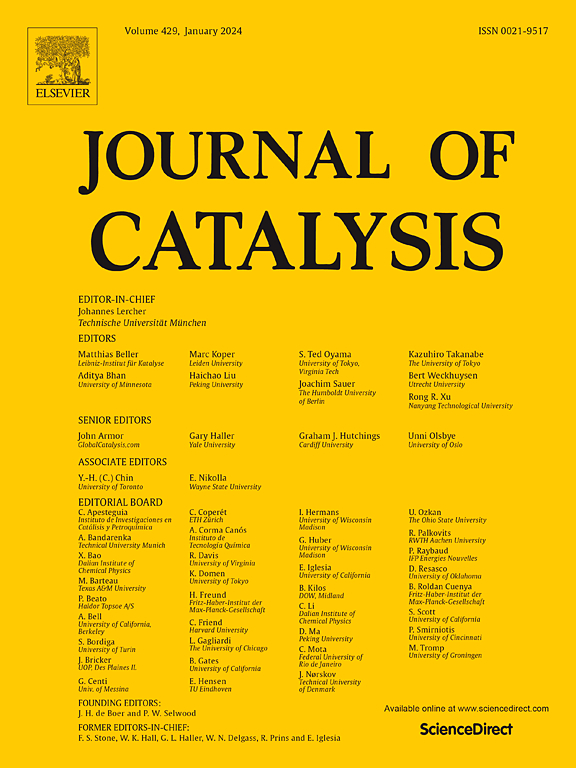znin2s4基异质结材料在光电催化中自由基介导的Cα-Cβ裂解
IF 6.5
1区 化学
Q2 CHEMISTRY, PHYSICAL
引用次数: 0
摘要
由于其固有的惰性和复杂的结构,选择性裂解木质素特定键以生产高价值化学品仍然是一个重大挑战。在这项研究中,我们开发了一种利用自由基的光电催化(PEC)策略,该策略在室温(从10 °C到35 °C)下实现了木质素解聚的高催化效率。合成了一种由二维ZnIn2S4纳米片和碳纳米颗粒组成的异质结材料,以促进高效的电子转移和自由基生成。量子产率(2.1858)超过1,表明PEC过程中存在自由基链机制。机理研究表明,氧自由基与c中心自由基结合形成Cβ-OOH过氧化物中间体,导致CC键断裂。值得注意的是,氯自由基(•Cl)首次引入木质素PEC解聚,引发了c - β- h功能化、环化和开环反应。该方法实现了100% % Cα-Cβ的裂解和90% %以上的天然g单位木质素的质量转化。β-O-4二聚体的最高产率为233.34 mg g−1(苯甲醛)、66.03 mg g−1(苯乙酮)和54.98 mg g−1(苯酚)。该研究为木质素解聚成高价值化学品的自由基机制和催化策略提供了新的见解。本文章由计算机程序翻译,如有差异,请以英文原文为准。

Radical-mediated Cα-Cβ cleavage by ZnIn2S4-based heterojunction materials in photo-electro-catalysis
The selective cleavage of lignin specific linkages for production of high-value chemicals remains a significant challenge due to inherent inertness and complex structure. In this study, we developed a Photo-Electro-Catalysis (PEC) strategy utilizing radicals, which achieved high catalytic efficiency for lignin depolymerization at room temperature (from 10 °C to 35 °C). A heterojunction material composed of 2D ZnIn2S4 nanosheets and carbon nanoparticles was synthesized to facilitate efficient electron transfer and radical generation. The quantum yield (2.1858) exceeding 1 suggested a radical chain mechanism in the PEC process. Mechanistic studies revealed that oxygen radical combine with C-centered radicals to form a Cβ-OOH peroxide intermediate, leading to C![]() C bond cleavage. Notably, chlorine radicals (•Cl) were introduced for the first time in lignin PEC depolymerization, initiating Cβ-H functionalization, cyclization and ring-opening reactions. This approach achieved 100 % Cα-Cβ cleavage and over 90 % mass conversion of native G-units lignin. The highest product yields were 233.34 mg g−1 (benzaldehyde), 66.03 mg g−1 (acetophenone), and 54.98 mg g−1 (phenol) from the β-O-4 dimer. This study provides novel insights into radical mechanisms and catalytic strategies for lignin depolymerization into high-value chemicals.
C bond cleavage. Notably, chlorine radicals (•Cl) were introduced for the first time in lignin PEC depolymerization, initiating Cβ-H functionalization, cyclization and ring-opening reactions. This approach achieved 100 % Cα-Cβ cleavage and over 90 % mass conversion of native G-units lignin. The highest product yields were 233.34 mg g−1 (benzaldehyde), 66.03 mg g−1 (acetophenone), and 54.98 mg g−1 (phenol) from the β-O-4 dimer. This study provides novel insights into radical mechanisms and catalytic strategies for lignin depolymerization into high-value chemicals.
求助全文
通过发布文献求助,成功后即可免费获取论文全文。
去求助
来源期刊

Journal of Catalysis
工程技术-工程:化工
CiteScore
12.30
自引率
5.50%
发文量
447
审稿时长
31 days
期刊介绍:
The Journal of Catalysis publishes scholarly articles on both heterogeneous and homogeneous catalysis, covering a wide range of chemical transformations. These include various types of catalysis, such as those mediated by photons, plasmons, and electrons. The focus of the studies is to understand the relationship between catalytic function and the underlying chemical properties of surfaces and metal complexes.
The articles in the journal offer innovative concepts and explore the synthesis and kinetics of inorganic solids and homogeneous complexes. Furthermore, they discuss spectroscopic techniques for characterizing catalysts, investigate the interaction of probes and reacting species with catalysts, and employ theoretical methods.
The research presented in the journal should have direct relevance to the field of catalytic processes, addressing either fundamental aspects or applications of catalysis.
 求助内容:
求助内容: 应助结果提醒方式:
应助结果提醒方式:


